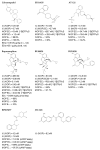Spotlight on Nociceptin/Orphanin FQ Receptor in the Treatment of Pain
- PMID: 35163856
- PMCID: PMC8838650
- DOI: 10.3390/molecules27030595
Spotlight on Nociceptin/Orphanin FQ Receptor in the Treatment of Pain
Abstract
In our society today, pain has become a main source of strain on most individuals. It is crucial to develop novel treatments against pain while focusing on decreasing their adverse effects. Throughout the extent of development for new pain therapies, the nociceptin/orphanin FQ receptor (NOP receptor) has appeared to be an encouraging focal point. Concentrating on NOP receptor to treat chronic pain with limited range of unwanted effects serves as a suitable alternative to prototypical opioid morphine that could potentially lead to life-threatening effects caused by respiratory depression in overdose, as well as generate abuse and addiction. In addition to these harmful effects, the uprising opioid epidemic is responsible for becoming one of the most disastrous public health issues in the US. In this article, the contributing molecular and cellular structure in controlling the cellular trafficking of NOP receptor and studies that support the role of NOP receptor and its ligands in pain management are reviewed.
Keywords: N/OFQ; NOP receptor; analgesia; ligands; nociceptin; nociceptin/orphanin FQ receptor; opioid receptor.
Conflict of interest statement
The authors have no conflict of interests to declare.
Figures



Similar articles
-
Nociceptin/orphanin FQ peptide receptor antagonist JTC-801 reverses pain and anxiety symptoms in a rat model of post-traumatic stress disorder.Br J Pharmacol. 2015 Jan;172(2):571-82. doi: 10.1111/bph.12701. Epub 2014 Jul 1. Br J Pharmacol. 2015. PMID: 24666365 Free PMC article.
-
Nociceptin/orphanin FQ and its receptor--potential targets for pain therapy?J Pharmacol Exp Ther. 2003 Aug;306(2):423-9. doi: 10.1124/jpet.102.046979. Epub 2003 Apr 29. J Pharmacol Exp Ther. 2003. PMID: 12721334
-
The biology of Nociceptin/Orphanin FQ (N/OFQ) related to obesity, stress, anxiety, mood, and drug dependence.Pharmacol Ther. 2014 Mar;141(3):283-99. doi: 10.1016/j.pharmthera.2013.10.011. Epub 2013 Nov 1. Pharmacol Ther. 2014. PMID: 24189487 Free PMC article. Review.
-
Nociceptin/orphanin FQ receptor antagonists as innovative antidepressant drugs.Pharmacol Ther. 2013 Oct;140(1):10-25. doi: 10.1016/j.pharmthera.2013.05.008. Epub 2013 May 24. Pharmacol Ther. 2013. PMID: 23711793 Review.
-
Potential of Nociceptin/Orphanin FQ Peptide Analogs for Drug Development.Chem Biodivers. 2021 Jan;18(1):e2000871. doi: 10.1002/cbdv.202000871. Epub 2020 Dec 22. Chem Biodivers. 2021. PMID: 33351271 Review.
Cited by
-
A genome-wide association study of European advanced cancer patients treated with opioids identifies regulatory variants on chromosome 20 associated with pain intensity.Eur J Pain. 2025 Jan;29(1):e4764. doi: 10.1002/ejp.4764. Eur J Pain. 2025. PMID: 39629963 Free PMC article.
-
Regulation of N-type calcium channels by nociceptin receptors and its possible role in neurological disorders.Mol Brain. 2022 Nov 24;15(1):95. doi: 10.1186/s13041-022-00982-z. Mol Brain. 2022. PMID: 36434658 Free PMC article. Review.
-
Endogenous opioid systems alterations in pain and opioid use disorder.Front Syst Neurosci. 2022 Oct 19;16:1014768. doi: 10.3389/fnsys.2022.1014768. eCollection 2022. Front Syst Neurosci. 2022. PMID: 36341476 Free PMC article. Review.
-
Analgesic Peptides: From Natural Diversity to Rational Design.Molecules. 2024 Mar 29;29(7):1544. doi: 10.3390/molecules29071544. Molecules. 2024. PMID: 38611824 Free PMC article. Review.
-
Discovery and structure-activity relationships (SAR) of a novel class of 2-substituted N-piperidinyl indole-based nociceptin opioid receptor ligands.Bioorg Med Chem. 2023 Sep 7;92:117421. doi: 10.1016/j.bmc.2023.117421. Epub 2023 Jul 21. Bioorg Med Chem. 2023. PMID: 37573822 Free PMC article.
References
Publication types
MeSH terms
Substances
Grants and funding
LinkOut - more resources
Full Text Sources
Other Literature Sources
Medical

